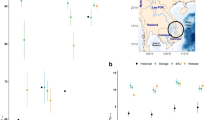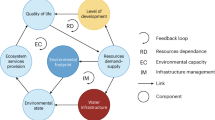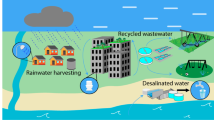Abstract
Managing freshwater resources sustainably under future climatic and hydrological uncertainty poses novel challenges. Rehabilitation of ageing infrastructure and construction of new dams are widely viewed as solutions to diminish climate risk, but attaining the broad goal of freshwater sustainability will require expansion of the prevailing water resources management paradigm beyond narrow economic criteria to include socially valued ecosystem functions and services. We introduce a new decision framework, eco-engineering decision scaling (EEDS), that explicitly and quantitatively explores trade-offs in stakeholder-defined engineering and ecological performance metrics across a range of possible management actions under unknown future hydrological and climate states. We illustrate its potential application through a hypothetical case study of the Iowa River, USA. EEDS holds promise as a powerful framework for operationalizing freshwater sustainability under future hydrological uncertainty by fostering collaboration across historically conflicting perspectives of water resource engineering and river conservation ecology to design and operate water infrastructure for social and environmental benefits.
This is a preview of subscription content, access via your institution
Access options
Subscribe to this journal
Receive 12 print issues and online access
$209.00 per year
only $17.42 per issue
Buy this article
- Purchase on Springer Link
- Instant access to full article PDF
Prices may be subject to local taxes which are calculated during checkout




Similar content being viewed by others
References
International Commission on Large Dams (2014); http://www.icold-cigb.org,
Zarfl, C., Lumsdon, A., Berlekamp, J., Tydecks, L. & Tockner, K. A global boom in hydropower dam construction. Aquat. Sci. 77, 161–170 (2014).
Stakhiv, E. Z. Pragmatic approaches for water management under climate change uncertainty. J. Am. Water Resour. Assoc. 47, 1183–1196 (2011).
Ansar, A., Flyvbjerg, B., Budzier, A. & Lunn, D. Should we build more large dams? The actual costs of hydropower megaproject development. Energy Policy 69, 43–56 (2014).
World Commission on Dams Dams and Development: A New Framework for Decision-Making (Earthscan, 2000).
Water and Climate Change Adaptation: Policies to Navigate Uncharted Waters (OECD, 2013).
Pearce, D., Atkinson, G. & Mourato, S. Cost-Benefit Analysis and the Environment: Recent Developments (OECD, 2006).
Brown, P. H., Tullos, D., Tilt, B., Magee, D. & Wolf, A. T. Modeling the costs and benefits of dam construction from a multidisciplinary perspective. J. Environ. Manage. 90, S303–S311 (2009).
Richter, B. D. et al. Lost in development's shadow: The downstream human consequences of dams. Water Alternat. 3, 14–42 (2010).
Liermann, C. R., Nilsson, C., Robertson, J. & Ng, R. Y. Implications of dam obstruction for global freshwater fish diversity. BioScience 62, 539–548 (2012).
Auerbach, D. A., Deisenroth, D. B., McShane, R. R., McCluney, K. E. & Poff, N. L. Beyond the concrete: Accounting for ecosystem services from free-flowing rivers. Ecosyst. Serv. 10, 1–5 (2014).
Tockner, K. & Stanford, J. A. Riverine flood plains: present state and future trends. Environ. Conserv. 29, 308–330 (2002).
Olden, J. D. et al. Are large-scale flow experiments informing the science and management of freshwater ecosystems? Front. Ecol. Environ. 12, 176–185 (2014).
Watts, R. J., Richter, B. D., Opperman, J. J. & Bowmer, K. H. Dam reoperation in an era of climate change. Mar. Freshwater Res. 62, 321–327 (2011).
Lovett, R. A. Dam removals: Rivers on the run. Nature 511, 521–523 (2014).
Vörösmarty, C. J. et al. Global threats to human water security and river biodiversity. Nature 467, 555–561 (2010).
Lehner, B. et al. High-resolution mapping of the world's reservoirs and dams for sustainable river-flow management. Front. Ecol. Environ. 9, 494–502 (2011).
Millennium Ecosystem Assessment Ecosystems and Human Well-Being: Wetlands and Water Synthesis (World Resources Institute, 2005).
Griggs, D. et al. Policy: Sustainable development goals for people and planet. Nature 495, 305–307 (2013).
Rockström, J. et al. The unfolding water drama in the Anthropocene: Towards a resilience-based perspective on water for global sustainability. Ecohydrology 7, 1249–1261 (2014).
National Action Plan: Priorities for Managing Freshwater Resources in a Changing Climate (Interagency Climate Change Adaptation Task Force, 2011).
Directive 2000/60/EC of the European Parliament and of the Council of 23 October 2000 Establishing a Framework for Community Action in the Field of Water Policy (European Commission, 2000).
Ecological Flows in the Implementation of the Water Framework Directive (European Commission, 2015).
National Water Initiative (Australian National Water Commission, 2005).
Folke, C. et al. Resilience thinking: Integrating resilience, adaptability and transformability. Ecology and Society 15, 20 (2010).
Pittock, J. & Lankford, B. A. Environmental water requirements: Demand managment in an era of water scarcity. J. Integr. Environ. Sci. 7, 75–93 (2010).
Gleick, P. H. Global freshwater resources: Soft-path solutions for the 21st century. Science 302, 1524–1528 (2003).
Tzoulas, K. et al. Promoting ecosystem and human health in urban areas using Green Infrastructure: A literature review. Landscape Urban Plan. 81, 167–178 (2007).
Milly, P. C. D. et al. Stationarity is dead: Whither water management? Science 319, 573–574 (2008).
Brown, C. The end of reliability. J. Water Resour. Plan. Manage. 136, 143–145 (2010).
Hallegatte, S. Strategies to adapt to an uncertain climate change. Glob. Environ. Change 19, 240–247 (2009).
Haasnoot, M., Middelkoop, H., Van Beek, E. & Van Deursen, W. A method to develop sustainable water management strategies for an uncertain future. Sustain. Dev. 19, 369–381 (2011).
Walker, W. E., Haasnoot, M. & Kwakkel, J. H. Adapt or perish: A review of planning approaches for adaptation under deep uncertainty. Sustainability 5, 955–979 (2013).
Reuss, M. Ecology, planning, and river management in the United States: Some historical reflections. Ecol. Soc. 10, 34 (2005).
Muller, M. The 'nexus' as a step back towards a more coherent water resource management paradigm. Water Alternat. 8, 675–694 (2015).
La Quesne, T., Kendy, E. & Weston, D. The Implementation Challenge: Taking Stock of Government Policies to Protect and Restore Environmental Flows (World Wildlife Fund, 2010).
Pahl-Wostl, C. et al. Environmental flows and water governance: Managing sustainable water uses. Curr. Op. Environ. Sustain. 5, 341–351 (2013).
Brown, C., Ghile, Y., Laverty, M. & Li, K. Decision scaling: Linking bottom-up vulnerability analysis with climate projections in the water sector. Water Resour. Res. 48, W09537 (2012).
Brown, C., Werick, W., Leger, W. & Fay, D. A decision-analytic approach to managing climate risks: application to the upper Great Lakes. J. Am. Water Resour. Assoc. 47, 524–534 (2011).
Stainforth, D. A., Allen, M. R., Tredger, E. R. & Smith, L. A. Confidence, uncertainty and decision-support relevance in climate predictions. Phil. Trans. R. Soc. A 365, 2145–2161 (2007).
Rocheta, E., Sugiyanto, M., Johnson, F., Evans, J. & Sharma, A. How well do general circulation models represent low-frequency rainfall variability? Water Resour. Res. 50, 2108–2123 (2014).
Sun, Y., Solomon, S., Dai, A. & Portmann, R. W. How often does it rain? J. Clim. 19, 916–934 (2006).
Wilby, R. L. & Dessai, S. Robust adaptation to climate change. Weather 65, 180–185 (2010).
Weaver, C. P. et al. Improving the contribution of climate model information to decision making: The value and demands of robust decision frameworks. WIREs Clim. Change 4, 39–60 (2013).
Steinschneider, S., Wi, S. & Brown, C. The integrated effects of climate and hydrologic uncertainty on future flood risk assessments. Hydrol. Process. 29, 2823–2839 (2014).
Ghile, Y., Taner, M., Brown, C., Grijsen, J. & Talbi, A. Bottom-up climate risk assessment of infrastructure investment in the Niger River Basin. Climatic Change 122, 97–110 (2014).
Singh, R., Wagener, T., Crane, R., Mann, M. & Ning, L. A vulnerability driven approach to identify adverse climate and land use change combinations for critical hydrologic indicator thresholds: Application to a watershed in Pennsylvania, USA. Water Resour. Res. 50, 3409–3427 (2014).
Aquatic Ecosystems, Water Quality, and Global Change: Challenges of Conducting Multi-Stressor Vulnerability Assessments (US Environmental Protection Agency, 2011).
Reed, M. S. Stakeholder participation for environmental management: A literature review. Biol. Conserv. 141, 2417–2431 (2008).
Poff, N. L. et al. The ecological limits of hydrologic alteration (ELOHA): A new framework for developing regional environmental flow standards. Freshwater Biol. 55, 147–170 (2010).
Wilby, R. L., Fenn, C. R., Wood, P. J., Timlett, R. & LeQuesne, T. Smart licensing and environmental flows: Modeling framework and sensitivity testing. Water Resour. Res. 47, W12524 (2011).
Gregory, R. et al. Structured Decision Making: A Practical Guide to Environmental Management Choices (John Wiley & Sons, 2012).
Moody, P. & Brown, C. Modeling stakeholder-defined climate risk on the Upper Great Lakes. Water Resour. Res. 48, W10525 (2012).
Moody, P. & Brown, C. Robustness indicators for evaluation under climate change: Application to the upper Great Lakes. Water Resour. Res. 49, 3576–3588 (2013).
Kareiva, P. M. Dam choices: Analyses for multiple needs. Proc. Natl Acad. Sci. USA 109, 5553–5554 (2012).
Armah, J. et al. Principles and Guidelines for Evaluating Federal Water Projects: US Army Corps of Engineers Planning and the Use of Benefit Cost Analysis (Report for the Congressional Research Service, 2009).
Kwadijk, J. C. et al. Using adaptation tipping points to prepare for climate change and sea level rise: a case study in the Netherlands. Wiley Interdisc. Rev. Climate Change 1, 729–740 (2010).
Millennium Ecosystem Assessment. Ecosystems and Human Well-Being: General Synthesis (World Resources Institute, 2005).
Poff, N. L. et al. The natural flow regime. BioScience 47, 769–784 (1997).
Bunn, S. E. & Arthington, A. H. Basic principles and ecological consequences of altered flow regimes for aquatic biodiversity. Environ. Manage. 30, 492–507 (2002).
Opperman, J. J., Luster, R., McKenney, B. A., Roberts, M. & Meadows, A. W. Ecologically functional floodplains: connectivity, flow regime, and scale. J. Am. Water Resour. Assoc. 46, 211–226 (2010).
Nilsson, C. & Svedmark, M. Basic principles and ecological consequences of changing water regimes: Riparian plant communities. Environ. Manage. 30, 468–480 (2002).
Cushman, R. M. Review of ecological effects of rapidly varying flows downstream from hydroelectric facilities. N. Am. J. Fish. Manage. 5, 330–339 (1985).
Steinschneider, S. & Brown, C. A semiparametric multivariate, multisite weather generator with low-frequency variability for use in climate risk assessments. Water Resour. Res. 49, 7205–7220 (2013).
Whateley, S., Steinschneider, S. & Brown, C. A climate change range-based method for estimating robustness for water resources supply. Water Resour. Res. 50, 8944–8961 (2014).
Maurer, E., Wood, A., Adam, J., Lettenmaier, D. & Nijssen, B. A long-term hydrologically based dataset of land surface fluxes and states for the conterminous United States. J. Climate 15, 3237–3251 (2002).
Haasnoot, M., Middelkoop, H., Offermans, A., Van Beek, E. & Van Deursen, W. Exploring pathways for sustainable water management in river deltas in a changing environment. Climatic Change 115, 795–819 (2012).
Ranger, N., Reeder, T. & Lowe, J. Addressing 'deep' uncertainty over long-term climate in major infrastructure projects: Four innovations of the Thames Estuary 2100 Project. EURO J. Decis. Process. 1, 233–262 (2013).
Grill, G. et al. An index-based framework for assessing patterns and trends in river fragmentation and flow regulation by global dams at multiple scales. Environ. Res. Lett. 10, 015001 (2015).
Dudgeon, D. et al. Freshwater biodiversity: Importance, threats, status and conservation challenges. Biol. Rev. 81, 163–182 (2006).
Poff, N. L., Olden, J. D., Merritt, D. M. & Pepin, D. M. Homogenization of regional river dynamics by dams and global biodiversity implications. Proc. Natl Acad. Sci. USA 104, 5732–5737 (2007).
Jager, H. I., Efroymson, R. A., Opperman, J. J. & Kelly, M. R. Spatial design principles for sustainable hydropower development in river basins. Renew. Sust. Energ. Rev. 45, 808–816 (2015).
Poff, N. L. Rivers of the Anthropocene? Front. Ecol. Environ. 12, 427–427 (2014).
Gedan, K., Kirwan, M., Wolanski, E., Barbier, E. & Silliman, B. The present and future role of coastal wetland vegetation in protecting shorelines: Answering recent challenges to the paradigm. Climatic Change 106, 7–29 (2011).
The Brisbane Declaration: Environmental Flows are Essential for Freshwater Ecosystem Health and Human Well-being (10th Int. River Symp., 2007); http://go.nature.com/MgROdG
Haasnoot, M., Kwakkel, J. H., Walker, W. E. & ter Maat, J. Dynamic adaptive policy pathways: A method for crafting robust decisions for a deeply uncertain world. Glob. Environ. Change 23, 485–498 (2013).
Hallegatte, S., Shah, A., Lempert, R., Brown, C. & Gill, S. Investment Decision Making Under Deep Uncertainty: Application to Climate Change (World Bank Group, 2012).
Wiens, J. A. & Hobbs, R. J. Integrating conservation and restoration in a changing world. BioScience 65, 302–312 (2015).
Humphries, P. & Winemiller, K. O. Historical impacts on river fauna, shifting baselines, and challenges for restoration. BioScience 59, 673–684 (2009).
Acreman, M. et al. Environmental flows for natural, hybrid, and novel riverine ecosystems in a changing world. Front. Ecol. Environ. 12, 466–473 (2014).
Moyle, P. B. Novel aquatic ecosystems: The new reality for streams in California and other mediterranean climate regions. River Res. Appl. 30, 1335–1344 (2013).
Allen, C. R., Cumming, G. S., Garmestani, A. S., Taylor, P. D. & Walker, B. H. Managing for resilience. Wildlife Biol. 17, 337–349 (2011).
Hobbs, R. J., Higgs, E. & Harris, J. A. Novel ecosystems: implications for conservation and restoration. Trends Ecol. Evol. 24, 599–605 (2009).
Richter, B. D., Mathews, R., Harrison, D. L. & Wigington, R. Ecologically sustainable water management: Managing river flows for ecological integrity. Ecol. Appl. 13, 206–224 (2003).
Arthington, A. H. Environmental Flows: Saving Rivers in the Third Millennium (Univ. California Press, 2012).
Suen, J-P. & Eheart, J. W. Reservoir management to balance ecosystem and human needs: Incorporating the paradigm of the ecological flow regime. Water Resour. Res. 42, W03417 (2006).
Yin, X-A., Yang, Z-F. & Petts, G. E. Reservoir operating rules to sustain environmental flows in regulated rivers. Water Resour. Res. 47, W08509 (2011).
Hermoso, V. et al. Systematic planning for river rehabilitation: integrating multiple ecological and economic objectives in complex decisions. Freshwater Biol. 57, 1–9 (2012).
Water Evaluation and Planning (WEAP) System (Stockholm Environment Institute, accessed 21 April 2014); http://www.weap21.org
Liang, X., Lettenmaier, D. P., Wood, E. F. & Burges, S. J. A simple hydrologically based model of land surface water and energy fluxes for GSMs, J. Geophys. Res. 99 (D7), 14415–14428 (1994).
Cuo, L., Lettenmaier, D. P., Mattheussen, B. V., Storck, P. & Wiley, M. Hydrologic prediction for urban watersheds with the Distributed Hydrology-Soil-Vegetation Model. Hydrol. Process. 22, 4205–4213 (2008).
Schoeman, J., Allan, C. & Finlayson, C. M. A new paradigm for water? A comparative review of integrated, adaptive and ecosystem-based water management in the Anthropocene. Int. J. Water Resour. Dev. 30, 377–390 (2014).
Acknowledgements
We acknowledge S. Steinschneider for developing the stochastic weather generator for the Iowa River Basin; S. Wi for the VIC hydrologic model development; D. LeFever for support in developing the reservoir systems model; and R. Olsen for his help in providing hydraulic modelling tools and economic information for the Coralville Lake flood control system. Special thanks to P. Clark for artwork in Fig. 1. Additional support for C.M.B. and C.M.S was provided by the NSF CAREER Award (CBET-1054762). The views in this article are those of the authors and do not necessarily represent the views of the OECD or its member countries. This article has been peer reviewed and approved for publication consistent with USGS Fundamental Science Practices (http://pubs.usgs.gov/circ/1367/,) and we thank J. Friedman of the USGS for his constructive comments. Any use of trade, firm, or product names is for descriptive purposes only and does not imply endorsement by the U.S. Government. This paper resulted from a synthesis project funded by the National Socio-Environmental Synthesis Center (SESYNC) under National Science Foundation Award #DBI-1052875.
Author information
Authors and Affiliations
Contributions
N.L.P. and J.H.M. conceived the original project. N.L.P., T.E.G. and C.M.B. led the drafting of the text. C.M.S., C.M.B., T.E.G. and N.L.P. led the case study analysis. N.L.P, C.M.B., T.E.G., J.H.M, M.A.P., C.M.S., R.L.W., M.H., G.F.M., K.C.D. and A.B. contributed to the intellectual content through workshop participation and writing.
Corresponding author
Ethics declarations
Competing interests
The authors declare no competing financial interests.
Supplementary information
Supplementary Information
Supplementary Information (PDF 1049 kb)
Rights and permissions
About this article
Cite this article
Poff, N., Brown, C., Grantham, T. et al. Sustainable water management under future uncertainty with eco-engineering decision scaling. Nature Clim Change 6, 25–34 (2016). https://doi.org/10.1038/nclimate2765
Received:
Accepted:
Published:
Issue Date:
DOI: https://doi.org/10.1038/nclimate2765
This article is cited by
-
A watershed moment for healthy watersheds
Nature Sustainability (2023)
-
Global transportation infrastructure exposure to the change of precipitation in a warmer world
Nature Communications (2023)
-
Regional water resources security assessment and optimization path analysis in karst areas based on emergy ecological footprint
Applied Water Science (2023)
-
A holistic view of sustainability in water resources management in the European Union: challenges and threats
Environment, Development and Sustainability (2023)
-
Developing a novel social–water capital index by gene expression programming
Environment, Development and Sustainability (2023)



